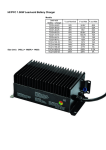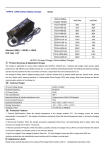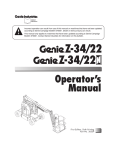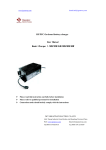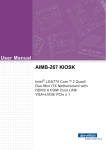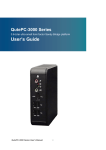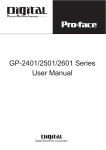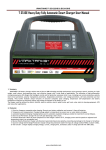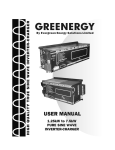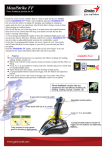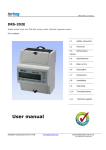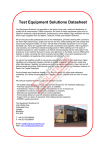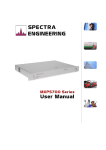Download to the LEAD ACID User Manual for the 4kw
Transcript
● ● HF/PFC 4KW Lead-acid Battery Charger ● Models Size (mm):367(L) × 352(W) × 139(H) Lead-acid Battery Charger TCCH-48-70 TCCH-60-60 TCCH-72-50 TCCH-84-42 TCCH-96-36 TCCH-108-32 TCCH-120-30 TCCH-144-24 TCCH-156-22 TCCH-168-20 TCCH-180-18 TCCH-192-18 TCCH-216-16 TCCH-240-14A4 TCCH-288-12 TCCH-312-11 V out Nominal V out Max A out Max 48V 60V 72V 84V 96V 108V 120V 144V 156V 168V 180V 192V 216V 240V 288V 312V 66V 82.6V 96.2V 112V 130V 144.7V 168V 192V 208V 233.3V 243V 258V 289.5V 337V 389V 417V 70A 60A 50A 42A 36A 32A 30A 24A 22A 20A 18A 18A 16A 14.4A 12A 11A I Product Summary & Application Scopes The charger is applicable for various Lead-acid batteries like Flooded, GEL, AGM, hemi colloid etc., It features light weight, small volume, stable performance, high efficiency and reliable security etc., It can be switched automatically between the floating and balancing charging and also has the protection functions of reverse connection, output short-circuit and overload and so on. The charger is widely used for battery-charging cycles in electric vehicles such as electric forklift, golf cars, electric trucks, electric tour bus, electric yacht, cleaning machines, or Uninterruptible Power Supply (UPS), solar energy, wind power dynamo and electric communication system on the railway etc. II Technical Target AC Input Voltage Range AC85V~AC265V AC Input Frequency 45~65 Hz AC Power Factor ≥0.98 Full Load Efficiency ≥93% Mechanical Shock & Conformance to Vibration Resistance Level SAEJ1378 Standard Environmental Enclosure IP46 Operating Temperature -40℃~+55℃ (-40℉~+131℉) Storage Temperature -40℃~+100℃ (-40℉~+212℉) 10 Charging Curves Charging Mode Charging Control III Available Intelligent temperature compensation, never to be charge-off or charge due Protection Features 1. Thermal Self-Protection: When the internal temperature of the charger exceeds 75℃, the charging current will reduce automatically. If it exceeds 85℃, the charger will shut down protectively. When the internal temperature drops, it will resume charging automatically. 2. Short-circuit Protection: When the charger encounters unexpected short-circuit, it will automatically stop to output. When fault removes, the charger will re-start in 10 seconds. 3. Reverse Connection Protection: When the battery is polarity reversed, the charger will cut off the connection between the internal circuit and the battery, and refuses to start. It can avoid any destroy. 4. Input Low-voltage & Over-voltage Protection: When the AC input Voltage is lower than 85V or higher than 265V, the charger will shut down protectively and automatically resume working with the voltage is normal again. IV Main Accessories & Wiring Diagram Accessories: Thermal Sensor TC-615 together with LED TC-618 (as per the specific vehicle model) or a single Thermal Sensor TC-615. Functions: Thermal sensor TC-615 provides the real-time detection of the battery’s temperature in the charging process to prevent charge-off or charge due. LED TC-618 shows the state of the charging such as <80% or >80% or 100% and can be fitted onto the vehicle panels. Wiring Diagram: Note: Thermal sensor and LED share the connector SP1310/P which pairs up with the charger’s communication port (SP1312/S, near the charger’s output terminal). Plug in the connectors before charging. Place the LED at the conveniently location. A thermal sensor should be fixed on the battery shell. Recommend to place it in middle position between two cells. Make sure the DC cord is connected to the battery properly. . Ⅴ Appearance Labels Please check carefully the labels on the casing of the charger before using in order to completing the transaction check the label on the charger before using, it can provide some help for you to understand the performance and the specification of the charger. i. Bar Code Label: Attaches on the output terminal of the charger. For example, SN10071001 1007: Production batch number. 1001: Bar code number. 48-25: Hardware model(48V 25A). HD VER 1.6 : Version number from the manufacturer ii. Model Label:take the model TCCH-48-25 for example INDUSTRIAL 48V BATTERY CHARGER Input:100~240VAC 50/60Hz Output: 48V Battery: Lead-acid Model: TCCH-48-25 14/8.1A 25A@240VAC 48V 24.5A@115VAC 24 cells Environmental Enclosure : IP46 a) “Input 100~240VAC 50/60Hz 14/8.1A”: The rated input current is 14A at 115VAC and 8.1A at 220VAC; b) “48V 25A@240VAC 48V 24.5A@115VAC”: The maximum output current is 25A at input 220VAC, and 24.5A at input 115VAC. iii. LED Label It is the important symbol to evaluate whether the charger works normally. The LED will flash red several times when AC is first connected, then the LED will flash green once. The number of red flashes denotes the present curve. e.g. If the red flashes three times, it means the present curve is curve 3, and so on. Red-Green flash (one second interval) Battery Disconnected Red flash (three seconds interval) Red flash (one second interval) Yellow flash (one second interval) Green flash (one second interval) Repair Battery <80% Charge Indicator >80% Charge Indicator 100% Charge Indicator iv. Charging Curves Label Ten charging curves respectively represent different capacities of the Lead-acid battery. I4 means the equalizing current. Algorithms_105 means the procedure code from the manufacturer. e.g. the charger of Lead-acid flooded battery 48V for example, 48V Flooded Battery-1.5KW Charger (Algorithms_105) Cur Amp Hour I4 Cur Amp Hour I4 1 105~126ah 3.36A 6 262~315ah 8.37A 2 126~152ah 4.04A 7 315~378ah 10.05A 3 152~182ah 4.84A 8 378~454ah 12.06A 4 182~219ah 5.81A 9 454~544ah 14.47A 5 219~262ah 6.98A 10 544~653ah 17.36A Charging Curves Setup (curve 1~10) 1. The LED will flash red several times when AC power is connected, and then the LED will flash green once. The number of red flashes denotes the present curve. E.g. If the red flashes three times, it means the present curve is curve 3. 2. To choose another curve, please cut off the power supply first, then uncover the label, pressing the button while connecting the power. If you want to choose curve 3, release the button after the 3rd LED Flash. Now the selected curve (e.g. curve 3) will be recorded in memory. If you want the charger to work with the selected curve (e.g. curve 3), cut off the power and reconnect it. Note: 10 charge curves are only available for volume order instead of sample order. VIII Common Faults & Solutions In case of the charging fails, please examine all the outside lines carefully to make sure that they are connected correctly. Apart from the circuit’s failure, please check the failure code of charging LED and handle it according to the following table. LED Flashing Indication Sequence (One Cycle) 1 RG______ Wrong Battery 2 RGR_____ Overcharged 3 RGRG____ Battery Overheated 4 RGRGR___ Incorrect AC Input Voltage 5 RGRGRG__ External Thermal Sensor Fault 6 RGRGRGR_ Communication Interface Fault 7 GR______ Charger Overheated 8 GRG_____ Charger Relay Fault 9 GRGR____ Charger Itself Fault Note: 1. R—red G—green 2. “_” denotes one second pause 3. Above LED flashing sequence is one cycle; the LED will flash repeatedly if the fault has not been removed. Solutions ▲ Wrong Battery: Verify the battery voltage range matching with charger or inspect the battery for damage. ▲ Overcharged: Confirm the battery capacity and the selected curve are matched or if the battery is defective. ▲ Battery Overheated: Check the temperature at the external thermal sensor. If overheated, the charger will start the battery protection. ▲ Incorrect AC Input Voltage: Check that the AC input voltage is in accordance with the requirement. ▲ External Thermal Sensor Fault: Ensure connect the thermal sensor correctly. ▲ Communication Interface Fault: Make sure the communication have been correctly connected or if it is damaged. ▲ Charger Overheated: Check if the ambient temperature is too high or the ventilation is smooth. ▲ Charger Relay Fault: Repair. ▲ Charger Itself failure: Repair. IX Charging Curve 1.The charging curve is custom build to your battery set. a.Typical charge curve for flooded 6v Lead Acid Trojan batteries (under temperature of 25℃) 1. Pre-charge: after connecting the charger and battery pack, the charger detects the voltage of the battery pack. It will pre-charge the cells or the pack when the voltage is between V1~V2 with constant current of I1.when the battery voltage reaches V2 (or the charging time reaches S1), it will enter the next stage of charging. 2. Constant current charging: charging current is I2, when the charging voltage reaches V3, it will enter the next step of charging. 3. Constant voltage limited current charging (or constant power charging). Charging voltage goes up gradually until the maximum point V4.under constant voltage, the charging current goes down to I3 (or the charging time reaches S3), it enters the next step. 4. Trickle charge: charge current turns to I4. Maximum voltage is V5, charging limited time is S4. 5. Floating charge:charge voltage is V6, charging time is S5 b.Temperature compensation curve (single cell):





